-
Paper Information
- Paper Submission
-
Journal Information
- About This Journal
- Editorial Board
- Current Issue
- Archive
- Author Guidelines
- Contact Us
Education
p-ISSN: 2162-9463 e-ISSN: 2162-8467
2022; 12(1): 16-26
doi:10.5923/j.edu.20221201.03
Received: Jul. 28, 2022; Accepted: Oct. 26, 2022; Published: Nov. 14, 2022

Impact Corona Virus (COVID-19) Pandemic on Engineering Laboratory Lessons: A Case Study of Selected Higher Education Institutions in Zambia
Chola Bweupe, Simon Tembo
Department of Electrical and Electronic Engineering, University of Zambia, Lusaka, Zambia
Correspondence to: Chola Bweupe, Department of Electrical and Electronic Engineering, University of Zambia, Lusaka, Zambia.
| Email: |  |
Copyright © 2022 The Author(s). Published by Scientific & Academic Publishing.
This work is licensed under the Creative Commons Attribution International License (CC BY).
http://creativecommons.org/licenses/by/4.0/

COVID-19 pandemic prevented physical converging of lecturers and students. Lessons that do not include laboratory sessions went on virtually, but there is need to know through the research what alternative was implemented for engineering laboratory lessons. Did students and lecturers just forego their engineering laboratory sessions during the pandemics lockdown and hope to have them after the pandemic eased off. The research aimed at establishing what alternative methods were used to deliver the engineering laboratory lessons, investigate the effectiveness of using virtual tools and platforms as an alternative to traditional face to face learning, if they compromise on the quality of education and to establish how best engineering laboratory lessons can be undertaken when physical engagement between lecturers and student is limited. It was vital to first assess what prevailed with regards to delivery of engineering laboratory lessons during the pandemic and hence the following findings: 61.21% of students did not have engineering laboratory sessions during the pandemic. 23.41% of students viewed virtual tools and platforms as an alternative to the traditional face to face engineering laboratory lessons as effective and 76.59% viewed them as not effective. If virtual engineering laboratory lessons compromise on the quality of education 70.68 of students said yes while 29.32% said no. Interview findings from lecturers indicated that a majority of laboratory lessons didn’t take place during the pandemic due to university infrastructure not able to accommodate the demand for virtual learning, slow internet speed, cost of internet and virtual laboratory learning hampered by lack of financial capacity by universities to provide the needed virtual tools and platforms.
Keywords: Engineering laboratory lessons during the COVID 19 pandemic, Quality of virtual laboratory lessons, Effectiveness of virtual laboratory lessons
Cite this paper: Chola Bweupe, Simon Tembo, Impact Corona Virus (COVID-19) Pandemic on Engineering Laboratory Lessons: A Case Study of Selected Higher Education Institutions in Zambia, Education, Vol. 12 No. 1, 2022, pp. 16-26. doi: 10.5923/j.edu.20221201.03.
Article Outline
1. Introduction
- Coronaviruses are a type of virus. There are many different kinds, and some cause disease. A coronavirus identified in 2019, SARS-CoV-2, caused a pandemic of respiratory illness, called COVID-19 [1]. The Corona-virus pandemic affected a lot of industries, and the delivery of education by Higher Education Institutions (HEIs) worldwide was no exception. HEIs were greatly affected in a way that the traditional method of learning that we all have been used to that allowed face to face interaction between lecturers and students drastically reduced due to the enforced lockdowns. One thing that may be overlooked is the impact the pandemic had on engineering laboratory lessons. It is a well-known matter that most HEIs resorted to alternative methods of education delivery by virtual tools and platforms for courses that do not involve laboratory sessions. But we need to know much about how laboratory lessons took place during the pandemic lockdowns. This research is interested in uncovering how engineering laboratory lessons took place at selected HEIs during the pandemic’s lockdowns at selected HEIs of Zambia. Most research looks at how theoretical lessons took place but what makes this research unique is its focus on what transpired with regards to engineering laboratory lessons during the pandemic lockdowns. The lack of engineering students’ interaction with laboratory apparatus during the pandemic’s lockdowns denied students the ability to feel, touch and experience lessons as they normally would do. This brings to our attention the following possible issues: A negative effect on engineering students’ academic performance, HEIs could have a low caliber of engineering graduates that may not be adequately skilled for the industry, this would in turn affect the overall engineering work produced by an entire country Zambia and eventually affect the economy in one way or another. All the challenges just go to show the negative impact that lack of engineering laboratory lessons could have on students and a country at large. There exist alternative ways of delivering engineering laboratory lessons especially during a pandemic, rather than completely not having laboratory lessons there is a possibility of utilizing virtual laboratories. A virtual laboratory can be defined as a simulated lab environment typically implemented as a software program which allows the users to perform their experiments [2]. The alternative methods of delivering engineering laboratory lessons virtually were analyzed by this research based on selected Universities of Zambia namely the University of Zambia (UNZA), Copperbelt University (CBU) and Mulungushi University.
1.1. Research Motivation
- Little is known about the quality of programs offered virtually in Zambia. Engineering departments, administrators, and policymakers need to know how their "customers" that is the student view the quality of online education programs based on their personal learning experiences and that is why this research had to get views from students extensively. The research requires the below questions to be addressed - What is the effectiveness of delivering engineering laboratory lessons by virtual tools and platforms. - Does the delivery of engineering laboratory lessons by virtual tools and platforms compromises on the quality of education - What is the best method that engineering laboratory lessons can be undertaken when physical engagement between lecturers and student is limited.The collected results will be compared against the global eLearning framework and standards and guidelines for quality assurance in higher education in Zambia to address the above-mentioned questions.
1.2. Research Aim
- The research intends to establish the effectiveness of delivering engineering laboratory lessons by virtual tools and platforms. Further the research intends to determine if the delivery of engineering laboratory lessons by virtual tools and platforms compromises on the quality of education and to determine the best method engineering laboratory lessons can be undertaken when physical engagement between lecturers and student is limited.
2. Overview and References to Related Work
- Educational institutions both private and public (schools, colleges, and universities) in Zambia are predominantly based on traditional methods (face to face) of teaching and learning. Education systems across the world, including Zambia, were forced to switch to remote teaching based on online platforms overnight. According to Lufungulos study majority of the lecturers had a negative attitude towards the introduction of online learning in the initial stages of its introduction. lecturers’ experiences and their interactions with students were both desirable and undesirable. The undesirable experiences included, technical difficulties, students’ low capabilities and confidence levels, time management, distractions during classes caused by connectivity issues, and lack of physical interactions with the students. In addition, lecturers indicated that poor ICT infrastructure, students’ economic status, digital illiteracy, digital divide, unsatisfactory online teaching training and lack of it and technology cost resulting in learning loses which subsequently affected the quality of education [3]. To see the strategic plans the HEIs had and how far they had gone in their implementation in readiness for any eventualities that may require use of eLearning platforms such as the COVID 19 pandemic that had presented itself. Plans to roll out online teaching and learning at one of the HEIs under the scope of this study. The University of Zambia (UNZA) go back several years. The plans are stated in the University of Zambia’s strategic plans 2013-2017 and 2018-2020. In the strategic plan 2013-2017 particularly strategic direction 7, the goal was to expand and promote the use of information and communication technologies across campuses by improving among other things internet connectivity. In the 2018-2020 strategic plan, objective number 1.2 stated that by 30 June 2020, the University will have implemented a fully-fledged e-learning platform for all university programs. Despite the university’s efforts of introducing e-learning platforms like the Moodle platform, the findings from this reviewed related literature by Lufungulo was indicative of the fact that lecturers did not easily warm up to the idea of teaching online before the COVID-19 pandemic. The lecturer also bemoaned the inability of students to attend class due to a lack of ICT gadgets and money to connect to the internet. This is further supported by Mwila, Mudenda who elude that students in rural parts of Zambia described online learning as a financial burden associated with the cost of mainly their inability to buy good Android operating system-based smartphones and laptops. The cost was also mainly incurred from buying internet data bundles. The study has established that despite its devastating effects on humanity in general and specifically on education systems globally, COVID-19 has been a blessing in disguise. For the school of education at UNZA, the pandemic had been a catalyst at ensuring that UNZA achieves its strategic plan 2018-2020, objective number 1.2 which states that by 30 June 2020, the University will have implemented a fully-fledged e-learning platform for all University programs. The pandemic forced lecturers to move from their traditional forms of teaching to new innovative online methods, instructions, and pedagogies [3].The term Pedagogical will be used in this paper and it would be good to define it beforehand. It refers to the method and practices of a teacher. When people refer to the pedagogy of teaching, it means how the teacher delivers the curriculum to the class. It would be interesting to see how lecturers have adapted or modified their pedagogical with the coming in of virtual learning, more especially with virtual engineering laboratory lessons. For virtual learning brings new pedagogical techniques into the traditional forms of education and makes learning more personalized and convenient [4]. A well thought out pedagogy can improve the quality of teaching and the way that students engage in different activities. This increases the likelihood of students achieving their goals as they are more likely to participate in the classroom [5]. Zambia, a sub-Saharan country is not exempt from the problems of training effective engineers. Faced with economic and social challenges, engineering students are limited in their ability to effectively train remotely. Therefore, this paper by Dr. Mabvuto Mwanza of the University of Zambia took Zambia as a case study to analyze the effects and challenges of effectively educating engineers in times of COVID-19. The lockdown and closure of education institutions by governments created several challenges for universities more especially practical delivery for those courses that require structured practical activities or hands on practical in the laboratories such as engineering, science, technology, etc. Moreover, the lockdown and closure resulted in suspensions in laboratory or field works particularly with regards to practical activities in the engineering, science, and technology. most universities or engineering schools in Sub-Saharan African countries lacked the capacity to move from face-to-face laboratories to the online virtual laboratories. This meant delaying or postponement of several critical practical laboratory activities for students in engineering courses. His research established that 92% of the students sampled had no practical learning. Laboratory demonstrations were the dominate tool used to make sure students had practical training. The main tools used were Moodle, google forms, WhatsApp, and email. The main challenges experienced during online assessment were power cuts, poor internet connectivity and browser problems arising from the use of smart phones [6].
3. Evaluating Quality of Education
- It is vital to mention guidelines that are used in the evaluation of the quality of virtual education. This is because we will need to compare the results of this research collected data to the standards to see if the HEIs adhered to the standards. Below we will look at international and local (Zambian) guidelines in the delivery of virtual education).
3.1. Global eLearning Frameworks
- According to Negin Barat Dastjerdi the main question of her study was what are the main components and sub-components of quality evaluation of virtual education? The answer was the evaluation in virtual education based on the proposed model by Khan 2005. Negin Barat Dastjerdi goes on to describe the components of the framework as Technological Factor This factor addresses technical infrastructures and assets that form the backbone of an eLearning entity. The technological infrastructure is viewed as the ensemble or ‘web’ of equipment, techniques, applications whose efficiency can be characterized in terms of availability and reliability, the adequate functionalities, usability, and integration into the existing infrastructure. This includes software, hardware, and infrastructures planning.Pedagogical factor this factor, which addresses the process of learning and teaching in terms of how learning and teaching is carried out (communication, collaboration, and interaction), is at the core of eLearning environments. Accordingly, the pedagogical factor is most critical when constructing a high-quality eLearning. It includes content analysis. Ethical factor this factor consideration of eLearning related to social and political influence and digital divided.Evaluation Factor this factor centers on examining the effectiveness of the institution, program, and course (how and to what extent learning objectives are met). The above will be compared with the findings from our research to see if the practices by the HEIs under the scope of our study adhered to the Khan global eLearning framework [7]. In addition, to design and deliver effective online instruction, instructors should know what qualifications they must have. First, they need to upgrade their technical skills to keep abreast of technological developments. Second, instructors need to know how to design interactive activities and course syllabi, how to operate the learning platform, and troubleshoot with problems online learners may encounter. Therefore, faculty receiving training before delivering online education courses is crucial [8]. In line with our research, it was discovered that lecturers did not undergo training on delivering virtual lessons and this compromised the quality and effectiveness of education delivered.Farida Saleem saw it necessary to investigate the students’ perceptions regarding their online learning experience during the COVID-19 pandemic to assess the quality of online learning in the context of a developing economy. Farida Saleems study is different from the other studies in the area in many ways. firstly, her study had been conducted in a country with limited energy resources that restrict the continuous flow of online learning. Secondly, it was conducted during the COVID-19 pandemic lockdown. Similarly, Zambia is a developing country and faces challenges of power making it necessary to bring out Farida’s findings. Farida highlights the various factors influencing online learning during the COVID-19 pandemic. It also provides insights for educational institutions to help them effectively manage the quality of learning and facilitate the students’ educational journey. Farida came up with the following factors affecting the quality of online learning which are:University support and quality of online learning Equipping the faculty members with the required knowledge, skills, and abilities contributed towards the delivery of quality education.Instructors’ support and quality of online learning. This is the belief students have that their lecturers were effective when they were responsive and enthusiastic.Situational factors as moderator include factors like hands-on/practical training, student-student interaction, interpersonal and communication skills, student-teacher interaction. Farida’s view on this one is that lack of hands-on training shatters one’s confidence and restricts one’s forward mobility. In the online scenario, the faculty members deliver the material by either speaking or recording their lectures, thus limiting opportunities for hands-on training for the students. This lack of hands-on training could have negative consequences for the quality of online learning [9]. Similarly, the problems that the Zambian HEIs may have faced during the pandemic could fall under the factors Farida identified as factors that affect the quality of online learning.
3.2. Standards and Guidelines for Quality Assurance in Higher Education in Zambia
- Above we have reviewed literature and frameworks that can be used in evaluating the quality and effectiveness of virtual education. It is prudent that we look at local standards and guidelines for the sake of comparing if the 3 HEIs under the scope of this study adhered to the set local standards of virtual learning in Zambia. One of the core functions of the Higher Education Authority (HEA) is to develop and monitor standards of various aspects of higher education. Standards are critical to the development of a robust higher education sector as they promote a culture of quality and facilitate excellence in the provision of education by (HEIs). Thus, in accordance with its mandate, the Authority developed the Zambia Standards and Guidelines for Quality Assurance in Higher Education (ZSG-QA) to promote a culture of quality among HEIs in Zambia. The ZSG-QA have been aligned to the Africa Standards and guidelines for Quality Assurance in higher education and benchmarked against international best practices from the Southern African Development Community region and other global actors in higher education. The ZSG-QA requires that a higher education institution shall ensure adherence to the teaching and learning environment (e.g., classrooms, laboratories, library etc.) and resources (e.g., study resources, teaching and learning equipment etc.) are appropriate and adequate to support each student. A higher education institution conducting courses requiring the use of laboratories or specialized facilities as part of instructional facilities shall, in addition to providing lecture rooms or lecture theatres, provide suitable laboratory facilities. It came to light through the research findings that the HEIs did not fully comply with the ZSG-QA regulations as will be explained further under the results and discussions [10].With the above global eLearning frameworks and local standards and guidelines for quality assurance discussed. They will be used to compare if the HEIs under the research scope adhered to them. The research came up with a conceptual framework which the research will also use to evaluate if the HEIs complied to the conceptual framework’s independent variables.
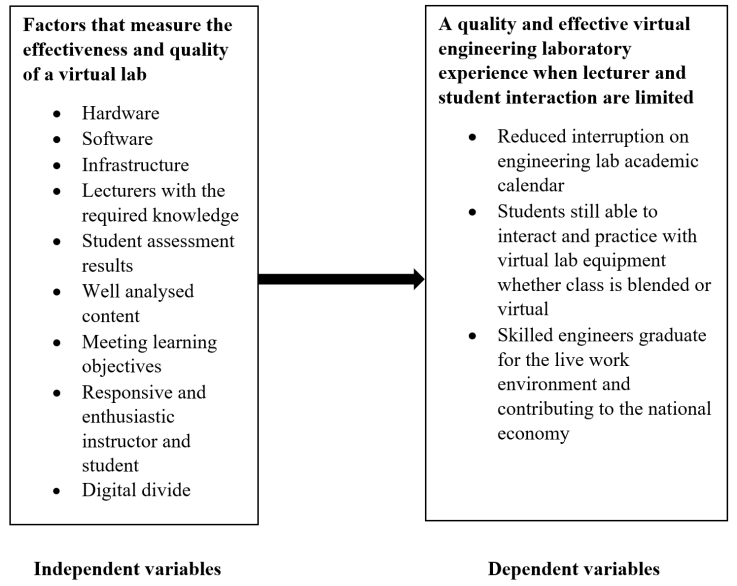 | Figure 1. Shows the research conceptual framework |
4. Methodology
- The methods that were used in the research are the qualitative and quantitative methods. They were chosen because this research aimed at establishing and evaluating the indicators that can be used to evaluate effectiveness and quality of virtually administered virtual labs. Also trying to see compliance to the indicators at the selected three (3) higher institutions of learning. This research will combine qualitative and quantitative methods to expand the evidence, improve the credibility of the findings and illustrate the results from one method with the results from the other one.Mixed methods research will combine elements of quantitative research and qualitative research to answer our research questions of- What is the effectiveness of delivering engineering laboratory lessons by virtual tools and platforms. - Does the delivery of engineering laboratory lessons by virtual tools and platforms compromises on the quality of education.- What is the best method that engineering laboratory lessons can be undertaken when physical engagement between lecturers and student is limited.Mixed methods will help this research gain a more complete picture than a standalone quantitative or qualitative study, as it integrates benefits of both methods.The quantitative method is necessary to gain some form of figures and percentages to establish whether for example students thought administering engineering lessons virtually can compromise on the quality of education and if it is effective. We can only make conclusions about certain data that is collected if it is in figure or percentage form and used for a wide audience of respondents and a quick way of collecting data. The two methods complement each other for the qualitative approach from lecturers’ compliments information collected from students in a more elaborative manner.Quantitative data was collected using questionnaires filled by engineering students at the three (3) selected HEIs and qualitative data was obtained from predetermined open-ended questions by a structured questionnaire. A total of 392 questionnaires were administered to engineering students. This response rate is enough to generalise the findings from the target population. In addition to arriving at the conclusions of the study.The attributes and population size for this study included students and lecturers of engineering. The study areas were selected due to the status of the HEI being one of the largest in the country and could offer a reliable result of what transpired during the pandemic when it came to administering of engineering laboratory lessons. The study areas were also manageable in terms of budget and required time.Simple Random Sampling was deployed in the selection of respondents, purposively sampled according to im-portance of the study in effectiveness and quality of delivering laboratory lessons virtually. This sampling technique aimed to gain knowledge from students and lecturers at the three (3) HEIs.SPSS (Statistical Package for the Social Sciences) program was used in quantitative analysis of data. Microsoft Excel was used to enter quantitative data, cleaning and analysis were done in SPSS.
5. Results
- The results of the research collected by the mixed method approach will be discussed in two (2) phases. The first will be from the engineering student perspective and secondly from the engineering lecturers. The results that follow depict what transpired with engineering laboratory lessons during the COVID 19 pandemic.
5.1. Engineering Laboratory Lessons During the COVID- 19 Pandemic- Students Perspective
- The research sample size was 344 engineering students. The research collected data from 392 engineering students.Figure 2 below shows the distribution of engineering students’ respondents by university.
 | Figure 2. Engineering students’ participation per university |
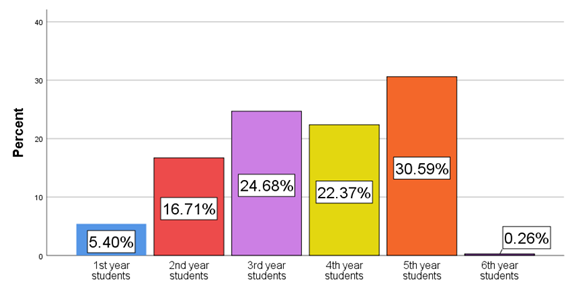 | Figure 3. Engineering student participation per year of study |
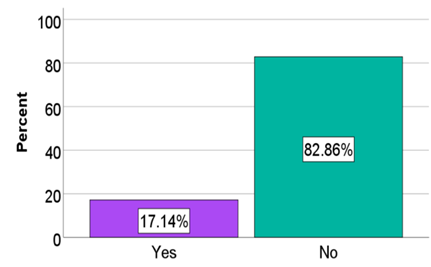 | Figure 4. Percentage of students that attended scheduled lab lessons |
 | Figure 5. Factors leading to students not attending scheduled virtual laboratory lessons |
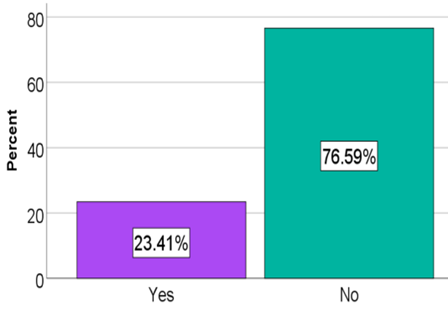 | Figure 6. How effective are virtual laboratory lessons |
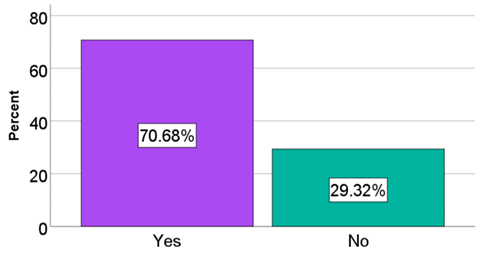 | Figure 7. Engineering students view if virtual labs compromise on the quality of education |
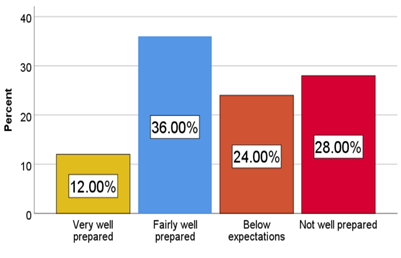 | Figure 8. Shows preparedness of lectures in administering virtual labs |
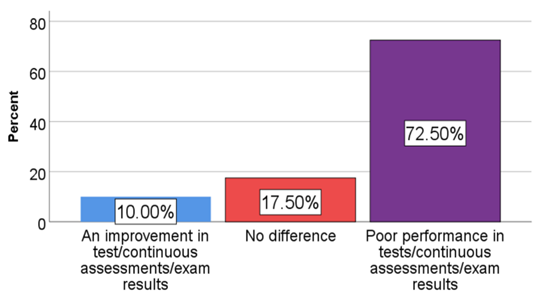 | Figure 9. Student academic performance during the pandemic |
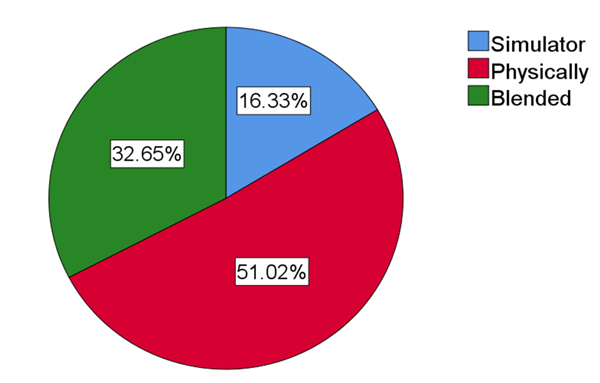 | Figure 10. Method of delivering laboratory lessons during the pandemic |
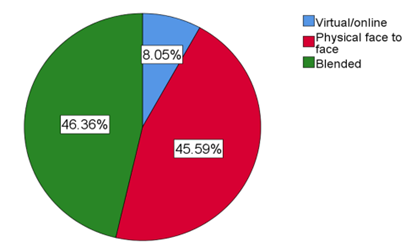 | Figure 11. Shows the view of students on best method of delivering engineering practical’s |
5.2. Engineering Laboratory Lessons During the COVID 19 Pandemic- Lecturer Perspective
- Below are the research results from the lecturers perspective on what transpired with engineering laboratory lessons during the COVID-19 pandemic.
5.3. Methods Used for Delivering Engineering Laboratory Lessons During the COVID-19 Pandemic
- Lecturer 1 For postgraduate students- Lecturer would send links to the software relevant for lab practice. The students would be required to practice at home. Aside for the labs the theoretical lessons were taught by zoom which had limited number of participants per session. Lecturer would have to record and upload the lecturer for student that didn’t attend zoom lecture. Done in order for other students have a chance to watch and listen to the lecture. Lecturer 2 The usual way of students going to lab to do the experiments but with adherence to the COVID-19 guidelines. Done only when pandemic had eased off.Lecturer 3 Both virtual and physically (blended) for some students had challenges having the lab lessons virtually so lecturers had to administer them physically at some point when the pandemic eased off.Lecturer 4 Physically by observing the COVID 19 re-strictions of 5 golden rules.Lecturer 5 Physically for hands on based laboratory lessons.
5.4. Tools Used by Lecturers During the Pandemic
- Lecturer 1 Open source through web sites. Zoom and Moodle platform for normal lectures other than labs lessons.Lecturer 2 Physical electrical tools.By code blocks and C++ for both on campus university and virtually.Lecturer 3 Electrical power system 1 for 4th year students (undergraduate) used PowerWorld (not internet de-pendent) work instructions sent to student while at home. Electrical engineering practice for 3rd year students used Multisim (offline and online based), power systems design and planning (postgraduate) used PowerWorld (not internet dependent) work instructions sent to student while at home.
5.5. Results from Lecturers on Issues that Influence the Success of Virtual Lessons Based on the Khan Global eLearning Framework
- When asked if lectures had the needed knowledge of the use of virtual tools and platforms in their effort to deliver lessons virtually. The response was that YES, all lecturers had re-quired knowledge with the use of virtual tools and platforms.When asked if lecturers underwent some sort of training to equip them to deliver lessons virtually during the pandemic. The response was. NO, the lecturers did not go under any training to equip them to deliver lessons virtually during the pan-demic.When asked if students were motivated in attending their virtual classes. The response was students were affected by increase in the cost to attend virtual classes as compared to physical classes as they were supposed to buy internet data every day and have in possession either a smart phone, laptop or desktop including living in an area with easy access to internet which was not possible in rural areas and in some peri-urban areas.When asked about how exams and assessments were administered to students during the pandemic. Response was that exams were conducted physically while assignments and tests were administered online. However, plagiarism was a concern by both lecturers and students. When asked about how lecturers' preparation of content when it came to delivering the lessons virtually. (Was the content well analyzed to ensure virtual lessons are delivered to students in a way that they can understand). The response was the lecturers did their best to prepare the contents according to the required course contents and were able to deliver the classes virtually although with hardships as they had to bear all the costs.When asked if lesson objectives were met by the delivery of lessons virtually. The response was YES on the theoretical part but not on the practical part because laboratory work was missing. Since engineering is hands on subject thus students are expected after learning the theory, they supposed to conduct practical’s. Thus, in the absence of practical’s the objectives are difficult to meet.When asked about how the enthusiasm of students and lecturers can be described during the delivery of lessons virtually. The response was. The enthusiasm was great for both parties in the beginning but as time progressed and costs increased it became difficult and the enthusiasm reduced.
5.6. Comparison of Research Results Against the Global eLearning Framework
- It is important to ensure that in as much as we wish to have flexible e-Learning it comes with its own issues that need to be addressed by ensuring compliance with frameworks. numerous factors help to create a meaningful learning environment, and many of these factors are systemically interrelated and interdependent. A systemic understanding of these factors can help designers create meaningful learning environments. Khan clustered these factors into dimensions: technological, pedagogical, ethical, resource support and evaluation. The E-Learning Framework can be applied to eLearning of any scope.Technological: The institutional dimension is concerned with issues of administrative affairs, academic affairs and student services related to e-learning.Pedagogical: The pedagogical dimension of e-learning refers to teaching and learning. This dimension addresses issues concerning content analysis, audience analysis, goal analysis, medium analysis, design approach, organization, and learning strategies.Ethical: The ethical considerations of e-learning relate to social and political influence, cultural diversity, bias, geo-graphical diversity, learner diversity, digital divide, etiquette, and the legal issues.Resource: The resource support dimension of the e-learning examines the online support and resources re-quired to foster meaningful learning.Evaluation: The evaluation for e-learning includes both assessment of learners and evaluation of the instruction and learning environment [11].
5.7. Evidence of HEIs Noncompliance to the E-learning Framework
- Evidence of HEIs noncompliance to the E-learning framework obtained from the research results are as follows.Research results on noncompliance to technological dimention Questionnaire results as depicted by figure 5, 37% of students gave unstable internet connection as the reason why they didn’t attend scheduled lab lessons. This is a technological dimention reason which ranked 1st amongst reasons students didn’t attend scheduled lab during the pandemic. Lecturers also brought out lack of internet connectivity as a challenge during the pandemic. Lecturers also mentioned a strain on university infrastructure. University infrastructure could not cope with the increased demand of faculties wanting to access education services online. University infrastructure required upgrade of servers and other equipment which isn’t easily done seeing that universities rely on government grants. Research results on noncompliance to pedagogical dimention According to figure 6, students thought 76% of students viewed virtual labs as not effective. Reasons given were pedagogical reasons that at times it’s difficult to understand practical’s by watching online. Research results on noncompliance to ethical dimention This is evidenced through the lack of virtual tools and platforms, funds to purchase internet bundles this can be seen from figure 5 above that depicts a digital divide. Universities do not have necessary virtual tools and platforms. Most government universities are underfunded and licenses to use some of these tools can be quite expensive.Research results on noncompliance to resource support dimention Lecturers brought out the issue of not being able to render support to students whilst students learned from home. Support could not be rendered due to poor net-work connection and lack of students understanding the help rendered as student and lecturer not physically together.
|
5.8. Comparison of Research Results with Standards and Guidelines for Quality Assurance in Higher Education in Zambia
- The comparison is done to see the level of adherence by the HEIs on ensuring an effective delivery of lab lessons virtually that meet the already mentioned guidelines of the ZSG-QA in the above sections. It was found that HEIs were not fully compliant to the ZSG-QA technological aspect in ensuring that infrastructure, software, and hardware are made available for the effective delivery of virtual labs and lessons. Virtual tools and platforms not available at HEIs as evidenced from findings from table 1 of the dimensions of e-learning framework above under the technological dimension. In ensuring that dedicated, adequate and relevant number of facilities and equipment shall be available for the support of a given eLearning program and shall include appropriate laboratory facilities this is not being adhered to fully.
6. Discussion of Results
- Comparison of research results against selected dimentions of eLearning framework above in table 1 shows a lot of concern. Most of the results collected from students and lecturers show a major gap when compared against Khans dimensions of eLearning framework. This is more especially in the technology dimension that had several non-compliances by the HEIs. At this point the research objectives can be concluded that laboratory lessons if delivered virtually would compromise on the quality of education and would not be effective. If the constraints shown in figure 5 are not addressed. Another point of discussion is that the COVID 19 pandemic forced virtual labs to be attempted to be delivered virtually. This did not prove to be effective and compromised on the quality of education. Most lecturers resorted to having physical lab lessons only at times the pandemic eased off. This conclusion follows assessments from student questionnaires and lecturer interview.To answer one of the research objectives of the best method engineering laboratory lessons can be undertaken when physical engagement between lecturers and student is limited. The below answers the objectives question. It has come to the attention of this research through the collected data from lecturers and students that delivering labs virtually is dependent on the following:The year a student is in. It is advised that if students are in their early engineering learning stages, they are to have blended lessons that is theoretical lessons done virtually and lab lessons done partly physically and partly virtually. In short, the blended method of delivering virtual labs would be best at the selected HEIs that are under the scope of this study in scenarios that student and lecture interaction is limited. Especially considering that our economy is a developing one where most infrastructure still requires a lot of attention. But of course, this method will still demand an improvement on the technological dimension of Khan eLearning framework. The other determining factor on what method should be used in the delivery of virtual ab lessons is the nature of the course. Best method engineering laboratory lessons can be undertaken when physical engagement between lecturers and student is limited also is dependent on the nature of the course. A civil and environmental engineering lecturer was interviewed and indicated that his course involves lab sessions. The lecturer however, indicated that it would be quite difficult to shift the labs virtually in a situation where there is limited contact between lecturer and student. This is because the nature of the civil engineering labs cannot be done virtually hence this course lab can only be done physically. Hence blended is advised for such labs of difficult nature for example soil testing from such a course can only be tested physically.It should be noted that what came out pronounced from the Ministry of Education, Zambia’s education authority the Higher Education Authority of Zambia, UNZAs department of quality assurance was the need to ensure staff that are delivering the virtual lessons are conversant with the tools and platforms. This can only be done if training is administered to the lecturers. However, it came to the attention of the research that through lecturer interview that lecturers did not receive training on delivering education using virtual tools and platforms.When it came to putting the variables of the conceptual framework to the test the results are as follows. The hardware, software and infrastructure were seen from the research results that they had the biggest gap that HEIs must tackle. Infrastructure is the technological backbone of delivering virtual labs successfully. It came to the research attention that lectures with the required knowledge on how to conduct virtual labs generally requires to be improved on however, institutions such as UNZA responded that their lecturers had knowledge on delivery but did not undergo training. The conceptual framework student assessment attribute did not unveil positive results as students’ results went down as shown from both student and lecturers’ responses in figure 9. Exams were conducted physically while tests and as-assessments administered online. If content was analyzed by lecturers in their delivery of virtual lessons, lectures confirmed that lecturers did their best to prepare the contents according to the required course contents and were able to deliver the classes virtually although with hardships as they had to bear all the costs. In meeting learning objectives, the response from lectures was that. Objectives were met on the theoretical part but not on the practical part because laboratory work were missing. Since engineering is hands on subject thus students are expected after learning the theory, they supposed to conduct practicals. Thus, in the absence of practical’s the teaching objectives are difficult to meet. On the responsive and enthusiasm of instructor and student from the results collected the enthusiasm was great for both parties in the beginning but as time progressed and costs increased it became difficult and the enthusiasm reduced. To conclude on the conceptual framework it means that the conceptual frameworks independent variables have a huge gap at the selected HEIs and hence have a negative impact on the dependent variables and it would mean not achieving the following dependent variables namely reduced interruption on engineering lab academic calendar; students still able to interact and practice with virtual lab equipment whether class is blended or virtual; and Skilled engineers graduate for the live work environment and contributing to the national economy.
7. Conclusions
- Findings from this research indicate that the main factor inhibiting the delivery of virtual engineering lessons and ensuring that the delivery adheres to global eLearning frameworks and local guidelines on eLearning and HEI quality assurance frameworks is technological. Most HEIs have been facing the technological challenge of ensuring that relevant infrastructure, hardware, and software are made available to students to effectively deliver virtual engineering labs virtually with while adhering to the eLearning quality frameworks. The lack of lecturers with the required technical expertise in administering the virtual labs and management contributes to noncompliance. The need to ensure lecturers are well vested on how to deliver virtual labs by undergoing necessary training stood out as guided by the Ministry of education and some HEIs quality departments. This affects the effectiveness and quality of the virtual engineering labs, thereby not exposing students to the much-needed hands on practice sessions when lecturer and student contact is limited in cases such as the one the COVID 19 pandemic brought. Further, the lack of preparedness by HEIs came out strongly from lecturers. If only HEIs can now learn from the impact the pandemic had on the education sector will future generations not feel the impact as much. Government and HEIs need to continually work together after the pandemic in ensuring that virtual tools and platforms are available and developed locally if possible. Ensuring that there is proper stable internet connectivity and cheaper learning gadgets such as computers can close the digital divide.The research discussed factors that influence the non-compliance to an eLearning framework and local guidelines on quality assurance from the ZSG-QA of the Higher Education Authority of Zambia. The results from the study were compared against an eLearning framework and the local guidelines on quality assurance from the ZSG-QA. The comparison was done to establish if HEIs under the research scope adhered to the required standards of delivering virtual laboratory lessons to students during the pandemic. Comparison showed obvious gaps, prominent were technological. From the comparison and discussions already done in this paper we have seen how virtual lessons were undertaken, what tools were used and constraints that were faced. It is the research conclusion that engineering labs lessons that were conducted virtually compromised on the quality of education and were not effective during the pandemic. This conclusion is taken from the comparison of the research results with the requirements of the eLearning frameworks were most HEIs did not perform well against the eLearning frameworks dimensions and the local ZSG-QA requirements. On which is the best method engineering laboratory lessons can be undertaken when physical engagement between lecturers and student is limited. The answer is not cast and concrete. It is dependent on the nature of the course, availability of tools and the year students. It would be best practice that if students are in their early engineering learning stages, they are to have blended lessons that is theoretical lessons done virtually and lab lessons done partly physically and partly virtually. In short, the blended method of delivering virtual labs would be best at the selected HEIs that are under the scope of this study in scenarios that student and lecture interaction is limited. Going forward there is a serious need for universities to improve on their technological infrastructure for this is the backbone of virtual learning. Universities and government need to work together in ensuring students never lag behind again when student and lecturer interaction is limited as the COVID 19 pandemic had presented.
ACKNOWLEDGEMENTS
- I am grateful to my supervisor, Dr. Simon Tembo for his continuous guidance and making me achieve more than I could imagine. I am thankful to the assistance and interest shown by the Ministry of Education and the Higher Education Authority of Zambia. I hope this research will assist the organisations in embracing virtual tools and platforms in the delivery of education.
 Abstract
Abstract Reference
Reference Full-Text PDF
Full-Text PDF Full-text HTML
Full-text HTML